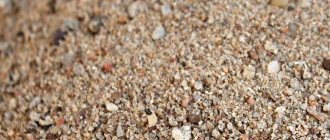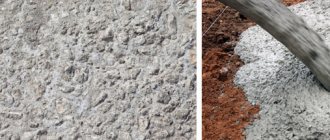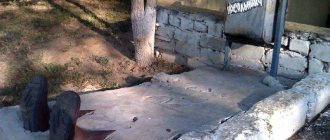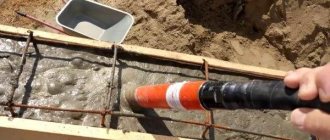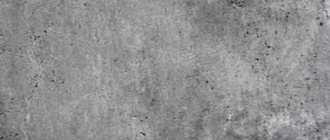Concrete M550 is one of the most durable and expensive types of mixtures, which are usually not used in residential and industrial construction, but are relevant in the construction of special-purpose structures. The properties of concrete are several times higher than the required parameters for the construction of conventional buildings, so it is simply unprofitable to overpay for such an expensive mixture.
Concrete 550 is widely used in the creation of special objects that require increased requirements for water resistance, strength, durability, resistance to loads and pressure.
The quality and strength of concrete are strictly controlled by the standards specified in GOST 10181 and GOST 26633-91. A mixture is produced based on granite crushed stone, river or ravine sand, cement, water and various plasticizers (increasing the ease of working with concrete).
Composition and proportions
Severe operating conditions and high pressure levels require the purchase of only high quality materials, which is reflected in GOST 7473-2010:
- binder – Portland cement grade M500;
- coarse aggregate – granite crushed stone;
- fine aggregate - clean sand (sea or river);
- water without the presence of foreign particles in the form of salts, petroleum products and organic matter;
- chemical additives – superplasticizers.
To obtain a high-quality solution, manufacturers of class B40 concrete adhere to the following proportions.
| Cement brand | Cement | Sand | Granite crushed stone |
| M500 | 1 | 1,7 | 2,6 |
Manufacturing Features
Concrete B40 (strength class) is produced from the following components: cement, sand, granite crushed stone, water. The base of the batch is prepared from these materials, then various plasticizers and modifiers are added to the mixture, designed to make it more comfortable to work with.
Concrete B40 (grade M550) involves the use in production of exclusively high-quality components, which directly affect the level of strength and reliability of the monolith.
To prepare concrete, take part of M500 cement, 2.4 parts of granite crushed stone, 1.1 parts of sand, water and a plasticizer. Additives make the mixture more workable and prolong the hardening period (otherwise the solution will begin to harden right during mixing and will not gain optimal strength).
What is needed to mix 1m3 of B40 concrete:
- Cement M550 - about 475 kilograms
- River/ravine sand – minimum 810 kilograms
- Granite or crushed stone - about 1075 kilograms
- Water – 170 liters
- Plasticizer – 9 kilograms
Concrete 40 is produced exclusively in a factory using special equipment, which makes it possible to control compliance with the mixture preparation technology: temperature, correct sequence of adding components, water hardness indicator, homogeneity of the final mass. You can order concrete for your project directly from the plant - both Moscow and the regions offer a large selection of manufacturers.
Production technology
For the proper mixing process, all components must be free of debris and foreign particles.
In the factory, class B40 concrete is mixed in huge cylindrical blocks, where dry mixtures and the required volume of water are automatically added. The mechanisms give the solution the required homogeneity for subsequent pouring.
If there are no companies nearby that deliver ready-made construction mixtures, then you will need a gravity mixer that can accommodate a large volume. It is installed on a flat area directly next to the pouring site to reduce labor costs.
It should be remembered that the solution sets quickly and must be poured immediately after mixing.
The addition of plasticizer is carried out in accordance with the exact instructions indicated on the packaging.
Strengthening process
Chemical reactions to bind all components of the mixture begin immediately after mixing begins. The process of gaining strength in the final product occurs in waves, and over time the rate decreases:
- poured concrete gains up to 60% hardness within the first 5 days;
- the concrete mixture hardens by 70% after 10 days from the date of filling the form;
- the finished product hardens completely 28 days after concreting.
To increase the strength indicators, the concrete surface is covered with a film for a month to increase the hydration period. At temperatures exceeding 25 °C, the concrete layer should be watered with water to ensure smooth progress of strength gain.
Technical characteristics of concrete M500 GOST 7473-2010
The main characteristics and cost of concrete of this brand depend on the type of coarse filler (crushed granite, gravel) and the amount of additives in accordance with the ordered indicators of mobility, frost resistance and water resistance. In general, the characteristics of concrete M500 correspond to the table:
| Type of concrete | Heavy, high strength, hydraulic |
| Brand | M 500 |
| Concrete class M500 | At 40 |
| Compressive strength of concrete | 525 kg/cm2 (52.5 MPa) |
| Mobility | P2-P4 |
| Frost resistance | F200-F300 |
| Waterproof | W10-W14 |
| Density of concrete M500 | 2265-2337 kg/m3 (granite crushed stone-gravel) |
| Weight of concrete cube M500 | 2265-2337 kg (granite crushed stone-gravel) |
| Concrete hardening time | 1-2 hours |
| Average cost of concrete M500 | 4,200-5,200 rub./m3 |
It should be noted that the average cost of 1 m3 of material is indicated in the format “at the time of publication of the article” and may subsequently change up or down in accordance with market conditions and rising prices for materials.
Properties and characteristics
Concrete class B40 refers to heavy and high-strength types of building mixtures and has the following characteristics:
- compressive strength – 523.86 kgf/cm2;
- density – 2200-2400 kg/m3. Such a large weight is explained by the presence of granite crushed stone in the composition;
- frost resistance is in the range F200-F300. A structure filled with this solution can survive up to 300 cycles of freezing followed by defrosting;
- high water resistance – W10-W14. Allows the construction of buildings exposed to constant moisture;
- mobility of the finished mixture – P2-P4.
Advantages
- High strength indicators;
- you can build buildings in cold regions with constant precipitation;
- fits well into shape.
Flaws
- High price;
- the rapid hardening of the finished solution does not allow ordering it from concrete plants located at a considerable distance.
Concrete B40: characteristics
This brand of concrete is distinguished by very high performance and properties that are relevant for the implementation of various projects. When choosing a concrete mixture, you must study all the parameters in order to be able to decide on the brand and the optimal price/quality ratio.
Main indicators of concrete M550:
- Strength - B40 concrete can withstand loads of at least 523.87 kgf/cm2: the mixture can be used for the construction of special objects and buildings subject to severe load-bearing loads.
- The composition is based on the solution: granite crushed stone of expensive fractions, cement grades M500-M600, plasticizers and other additives.
- Water resistance - corresponds to class W10-W14: can be used in conditions of high humidity. It is a hydraulic type concrete that resists direct exposure to water without seepage.
- Frost resistance - B40 concrete demonstrates an F300 indicator: the maximum number of freezing cycles of the monolith is 200-300, the solution tolerates sudden temperature changes well, and maintains stable characteristics even with a large minus.
- Mobility is at the P3-P5 level: plasticizers help make concrete comfortable to work with.
- Hardness – within Z2-Z4
Areas and features of application
Concrete grade B40 has found wide application in the construction of special-purpose facilities built in places with harsh weather conditions:
- hydraulic structures - dams, dikes, water barriers, reservoirs, aqueducts;
- bank vaults;
- pouring a foundation in a swampy area;
- military facilities - bomb shelters, training grounds, weapons testing sites;
- subway laying;
- pouring supports for large bridges in areas with difficult terrain
Concrete class B40 is intended only for industrial construction. In the private sector, it is cost-effective due to its excessive strength, unnecessary for low-rise buildings, and the high price per 1 m3.
Use in construction
Concrete mortar is produced only at the factory, using a special technology, from high-quality components, so its cost is quite high, and its properties and parameters are not relevant in ordinary residential and industrial construction. There is no point in overpaying.
Therefore, class B40 is used only for the construction of individual objects where it is necessary to provide improved characteristics.
Where concrete M550 is used:
- Complex hydraulic structures - swimming pools, various types of water parks, dams and dams.
- Reinforced concrete structures that experience increased load-bearing loads during operation.
- Monolithic foundations for objects located in an area of increased seismic hazard.
- Design of bank vaults.
- Construction of modern subways.
- Construction of various types of military facilities - bomb shelters, bunkers.
- Creation of runways and highways with increased loads.
- The most critical elements of hydraulic structures can be underwater elements of foundations and bases, dams, berth walls, bridge supports, etc.
- Concrete B 40 is often used for casting columns used in the construction of serious architectural buildings.
- Creation of areas near powerful structures in the format of continuous monolithic sites.
Where to order quality concrete
Our concrete plant produces both common and rare brands of concrete. The recipe takes into account the specifics of the project and adds additives to obtain a unique mixture with optimal performance. You can order concrete with delivery according to a convenient schedule, so that the construction site does not stand idle, and the concrete arrives without loss of consumer qualities. Before sending the order for work, our specialists will help you choose the right mixture composition so that it is cheap and without loss of quality.
Comprehensive services from a single contractor are always more profitable than turning to a chain of intermediaries. It is important that the order is analyzed and certified in the factory laboratory, and the client is issued official documents. We understand the level of responsibility for the quality of our concrete products, therefore we strictly adhere to the required recipes. Sales are carried out only in the volume determined during control weighing; overpayments are excluded.
We offer the following services:
- the price for 1 m3 is indicated in the price list and cannot increase during the execution process;
- the composition is produced in accordance with GOST, taking into account the requirements of a specific order;
- delivery is carried out with a mixer of the required volume, the customer can remove the concrete with his own machine;
- travel time and route are determined by the navigator, escort to the construction site is provided;
- possibility of renting equipment during construction, round-the-clock support and repairs;
- travel and accompanying documents are provided, the equipment is driven by experienced drivers;
- Preferential payment options, installments and additional bonuses are available to regular and wholesale customers.
Our team takes upon itself the solution of all operational issues regarding the supply of products. After agreeing on the cost and approving the composition, the customer will only need to accept the concrete on time. Sales service operators will help in the most difficult cases, regardless of the terms and price of the contract.
Description of material
Initially, concrete was not particularly durable and was used to construct buildings several stories high.
Gradually, heavy varieties of this material began to appear on sale, intended for high-rise construction and the manufacture of structures that experience significant pressure during operation. The excellent strength of the working mixture is achieved due to the increased content of Portland cement in it and the use of various additives and additives. Today you can choose both basic compositions of heavy heavy-duty concrete M550, as well as moisture-resistant and frost-resistant varieties that can be used for external and internal work. They are distinguished by their ability to be transported over the longest possible distances without losing the quality of the working mixture.
How to order concrete
offers time-tested and convenient delivery conditions. We work according to the contract, we guarantee strict compliance with all clauses of the contract.
To buy factory-quality concrete, you will need to complete the following steps:
- contact us by phone or by leaving a message on the website;
- the details of the order are clarified with the employee: address, access roads, volume of concrete and delivery schedule, brand (class) and additional requirements for the composition;
- financial issues are resolved: the cost of concrete, payment options, the possibility of installments for a large order;
- after approval of contractual positions, the order is sent to production;
- after production, the concrete is weighed and shipped, copies of the passport and batch certificate are attached;
- the delivered concrete is loaded in the required manner to the location specified by the client;
- a document is signed stating that there are no claims, taking into account fully fulfilled obligations.
Our concrete is free of hidden markups; the price includes only the services necessary for the client. Call us, we will answer all your questions and promptly begin producing concrete with the required characteristics.
Concrete composition
Difficult operating conditions and high levels of loads on buildings and structures built on the basis of concrete of this grade determine the qualitative and quantitative composition of the components that should be used for its manufacture.
In general, for the preparation of a commercial mixture that meets the technical characteristics - B40; P4; F300; W14; The following components are used:
- Portland cement PC 500 D0.
- Sand for construction work, class 1, particle size modulus 2-2.5 mm.
- Granite or gravel crushed stone grade M1200, element fraction sizes 5-20 mm.
- Superplasticizer S-3, consumption 5-9 kg/m3.
- Pure water. The water-cement ratio is not more than 0.45.
Advantages and disadvantages
Like other types of concrete, the M550 brand has certain advantages and disadvantages, which are determined by the properties of the material. It is necessary to take into account all the advantages of the mixture in order to ensure the strength and durability of the structures being built. The characteristics of M550 concrete will vary depending on the additives, plasticizers, fillers and production technology used. The main advantages of the material include:
- excellent strength;
- reliability and durability;
- resistance to dynamic and static loads;
- frost and moisture resistance;
- possibility of long-term transportation.
Many builders consider the main disadvantage of concrete to be its high cost.
The substantial price is due to the high content of expensive Portland cement in the mixture, the complexity of the manufacturing technology and the need to use additional plasticizers if it is necessary to transport the material over long distances. Precisely because of its high cost, concrete 550 is not used very widely, since its increased strength and excellent characteristics are simply not in demand in ordinary residential construction.
READ Do-it-yourself concrete steps for a porch
Concrete grades
Material labeling is calculated in laboratories. To find out the exact data on strength, a cube is made from concrete mortar, which has sides of 150 mm, and then placed under a press and measurements are taken. Based on the information received, concrete grades are of the following types:
- M100
is a lightweight building material with a low level of strength. It has average frost resistance parameters (F50) and is usually used for preparation before the construction of buildings. - M150
- has higher strength parameters compared to M100, but also belongs to lightweight mixtures that are not suitable for the construction of load-bearing walls. The main area of its use is screeding, making paths, making stones for laying borders. - M200
is a popular type of material, widely used for screeds. When choosing concrete grades for constructing a foundation in a country house, this type is given preference only when the building is built on stable soils. - M300
is a universal building material that combines good strength, resistance to moisture and temperature fluctuations. Suitable for foundations of low-rise buildings, stairs or fences. - M350
– used for buildings with increased strength properties. It is purchased to create reinforced concrete slabs and other similar structures that will experience increased loads during operation. This brand is in great demand among developers of multi-storey buildings. - M400
– has high frost resistance and water resistance. The building material has significant mobility, so it is easy to install. It is used to build bridges, swimming pools, vaults in banking institutions, and other buildings that have special safety requirements for people.
Where is M500 concrete used?
High strength, density, zero water absorption and the highest possible frost resistance determined the scope of application of the M500 grade of concrete of class B40. In particular, concrete material of this type is used for the following types of concrete work:
- Construction of monolithic foundations for the construction of multi-storey buildings and military facilities.
- Construction of load-bearing supports for highways, bridge crossings and supports for other structures that can withstand high mechanical loads, in particular the foundations of high-rise buildings.
- Construction of hydraulic structures and structures operating in conditions of high humidity: subways, underground tanks, bunkers, bomb shelters, underground command posts.

